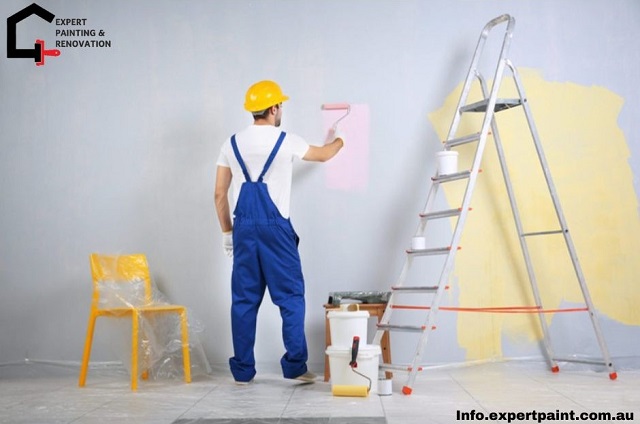Painting your house may appear to be one of those do-it-yourself tasks that anyone can complete with a brush a tin of paint and a free weekend. However any professional painter will tell you that getting a smooth perfect finish requires more than just passion—it also requires the proper planning supplies and methods.
At Expert Painters Melbourne we’ve witnessed innumerable instances where homeowners begin with confidence only to become frustrated months later due to peeling paint drips or patchy finishes. Avoiding these typical blunders can save you time and money as well as give your walls a polished appearance whether you’re updating your living room or painting the outside.
Let’s take a look at the five most common painting mistakes homeowners make—and how to avoid them.
1. Skipping Proper Surface Preparation
Hurrying into a painting project without adequate planning is one of the biggest (and most frequent) painting errors. A clean smooth and stable surface is essential for paint to adhere to.
The mistake:
Many do-it-yourself painters don’t realize how crucial it is to sand and clean surfaces before painting. Peeling or uneven finishes result from dirt dust grease and flaking paint preventing the new coat from adhering correctly.
How to avoid it:
The key is to prepare.
• To get rid of dirt and oils wash walls and surfaces with a mild detergent.
• Use filler to seal holes or cracks then smooth them out with sand.
• To create a surface that the new paint can adhere to lightly sand glossy surfaces.
• Before painting always wipe away dust with a moist cloth.
In Melbourne’s unpredictable climate where temperature and humidity can affect how paint adheres and dries taking a few extra hours to properly prepare will ensure that your paint job looks better and lasts longer.
2. Using Low-Quality Paint and Tools
While it’s tempting to save money on cheaper paint or brushes, this decision often costs more in the long run.
The mistake:
Low-cost paints usually have less pigment and binder which causes uneven color poor coverage and a finish that fades quickly. Similarly, cheap brushes and rollers may leave streaks or bubbles on the surface.
How to avoid it:
Invest in high-quality supplies from reliable manufacturers.
• In addition to having a better appearance high-quality paint is resistant to mildew fading and chipping.
• High-quality rollers and brushes offer smoother coverage and less splatter and drips.
• For water-based paints use a brush or roller with synthetic bristles for oil-based paints use natural bristles.
A professional painter always uses high-quality materials because they produce a finish that is both beautiful and long-lasting making them worthwhile investments.
3. Ignoring Primer (or Using the Wrong One)
Because they believe primer is superfluous or merely an up sell from the paint store, many homeowners choose not to use it. In actuality primer is what guarantees uniform paint adhesion and full color depth.
The mistake:
Patchy color and uneven sheen are frequently the result of painting directly over unprimed surfaces, particularly fresh plaster bare wood or patched areas.
How to avoid it:
• When painting over dark colors new drywall or raw materials primer should always be used.
• Select the surfaces appropriate primer (e. g. The g. bonding primer for glossy surfaces or stain-blocking primer for smoke or water damage).
• Primer is even more important for external surfaces because it seals porous materials and stops moisture from penetrating.
If you don’t use primer your paint job won’t last as long and might need to be redone in a year or two. This is a costly error to fix.
4. Painting in the Wrong Conditions
The weather in Melbourne can be erratic it may be sunny one minute and rainy the next. However, a lot of people are unaware of how important temperature and humidity are to paint drying and curing.
The mistake:
Painting on days that are exceptionally hot cold or humid may result in uneven drying streaks or poorly adhered paint. Painting indoors in an area with inadequate ventilation can also trap fumes and delay the drying process.
How to avoid it:
• Before beginning make sure the paint can is within the recommended temperature and humidity ranges.
• Steer clear of painting in direct sunlight or on hot surfaces.
• When painting indoors, make sure the area is well-ventilated by using fans and open windows.
• If you’re doing outside work in Melbourne, try to find mild dry days when there won’t be any rain for at least 24 hours. A flawless finish or a frustrating redo can be achieved with a little timing patience.
5. Rushing the Job (and Skipping the Details)
We understand that painting can be exhausting particularly when you’re halfway done and just want to finish. However hurrying the process frequently results in errors that are challenging to correct afterward.
The mistake:
Common shortcuts include applying thick coats not taping edges and not giving coats enough time to dry. Drips roller marks and uneven coverage result from these.
How to avoid it:
Apply thin even coats—two or three light coats are better than one thick one.
• Before applying the next coat let the previous one completely dry.
• For crisp lines remove the painters tape while the paint is still slightly tacky to achieve clean edges.
• Before continuing take some time to examine your work in well-lit areas. Professional painters work appears perfect because they devote more time to preparation and accuracy than to painting.
Final Thoughts: Leave It to the Experts
Painting is one of the most efficient and economical ways to update your house but it’s also easy to underestimate the skill and time required to do it correctly. While avoiding these typical errors can improve the appearance of your do-it-yourself project hiring skilled painters is always the best option if you want a professional finish that will last.

